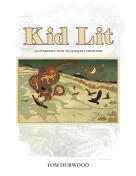
LitPick Review

Kid Lit: An Introduction to Literary Criticism by Tom Durwood is informative and interesting to read. It begins by briefly defining children’s literature, kid lit for short, and highlights its history. It covers coming-of-age resources well, so plans for future editions include adding information about picture books and some international literature too. The book is divided into three sections. The first clearly summarizes concepts such as identity, gender, social class, trauma, and war as they relate to literary criticism. It also discusses the basic elements of story structure and the empire theory of literature as simply as possible. The second part of the book, “In-Depth Studies,” contains editorial introductions as well as interviews and links to essays from scholars who have strong opinions about popular stories and movies. The book ends with Mr. Durwood’s expectations for his college classes, his mission, and lesson plans. While this book could be used as a detailed outline or textbook for a class, I see it as a reference book of ideas about critical thinking and writing because of the frequent author notes, scholarly essay information, sample lesson plan writing assignments, and thorough index it has.
Often people read stories including comics, play online video games, and watch movies for pleasure. They don’t think about them much beyond that, but this book considers these genres part of kid lit. As a result, Mr. Durwood challenges readers to look within the resources for deeper meanings each may have. He encourages people to question why some works have stayed popular over time and to look for the similarities and differences among them. He believes it’s important to think about how sources of entertainment might relate to history, politics, and world culture too. He builds an argument with examples for his own ideas, shows readers how scholars do the same, and invites people to practice justifying their ideas in their own writing. The process isn’t easy at first, but he’s found research that shows it develops skills that are highly valued in various professions. He also suggests that even when people disagree with one another, they have had an opportunity to think about ideas from a different perspective. This is what helps us become more knowledgeable and well-rounded over time.
Opinion:
This scholarly book is packed with information that is best suited for teachers and college students. It’s a collection of various kid lit ideas, so it is not intended to be read quickly beginning to end. I think probably the more it’s studied, the more information readers notice and learn. When I focused on small amounts of the book at one time, each idea seemed straight forward and well written. The author’s introductory notes and bold print statements inside text boxes highlighted important information. The numerous lesson plan writing assignments also looked challenging. The list of class expectations showed how student success is related to effort while the mission section explained the value of a good teacher. Both are reminders we all have a responsibility to do our best. I really liked the colorful photographs that consistently appear throughout. They grab readers’ attention and break up the seriousness of the text. I think the best part of the book is its emphasis on popular coming-of-age stories and movies. The familiarity most people already have with many of them can take away the fear they might feel if they’re practicing new academic skills such as thinking and writing critically for the first time.


